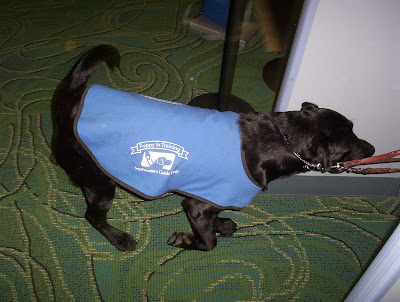As most of you know, the last puppy I raised was a very light-colored male yellow Lab named "Dodger" (actually "The Artful Dodger," after the character in Charles Dickens's novel Oliver Twist, since artfully dodging obstacles seems like a prime trait for a guide dog to have). Since I raised his mama and was friends with her breeder host, I've known Dodger almost since the day he was born. After a year together, Dodger went in for training this past June, and just two weeks ago, I got word that he had been matched with a visually impaired handler and was going on to become a working guide dog.
On Saturday, I was fortunate to be able to participate in an event that all Southeastern puppy raisers long for and eagerly await: Puppy Raiser Day! I got to meet Dodger's new handler, see Dodger in harness working, and of course see and pet Dodger for the first time since he went in for training over six months ago. Puppy Raiser Day is such an incredible experience that I wanted to share it with everyone who has not been there yet.
It's a hard fact of life that not every puppy raiser gets to experience Puppy Raiser Day. My first two puppies became breeders, so I had to wait a while before it was my turn. This day of celebration and interaction is also something that not every school does, so we are lucky to have this opportunity when it arises. I sincerely hope that everyone in our group gets to have this experience at least once. It is such a wonderful feeling seeing the puppy that you molded and played with and loved for so long go on to give someone else the gifts of mobility, independence, and dignity.
The day began with new Puppy Raising Services Communications Coordinator Carol Cohen (aka PRS CC CC) reading bios of all the students. When she was done, there was not a dry eye in the house. It is amazing and inspiring to hear the life stories of these visually impaired men and women – some blind since birth, some only recently losing their vision to disease, some totally blind, some able to see some things but dealing with serious visual impairment, some tentatively taking the next step in their evolution by getting their first guide dog, some dealing with the passing of a trusted and reliable partner and wondering if they'll ever find another one as good. And each one is now bonding with a new dog at his or her side that someone in the room nurtured and loved just for this purpose.
After the bios were read, we went outside to watch each new team do a route, eagerly waiting to see for the first time "our" dog in harness actually guiding someone. It is an indescribably moving moment. Dodger's new handler, Marty, has had a Southeastern guide dog before. Dodger is his second, and as you can see, they are already a great team. (Marty graciously gave me his permission to post and share these photos.)

After all of the new guide dog teams had completed their routes, they came out to the gazebo area on campus to meet the not-so-patiently waiting raisers and their families. I certainly enjoyed meeting Marty for the first time and looked forward to getting to know him better, but of course at first your anticipation is centered where your heart is, and you want to be reunited with the puppy you've been missing. Luckily, when I asked Marty if I could pet his dog, he said yes! It was great being able to once again feel Dodger's soft fur and big ears, and to give him a big hug. He seemed to like it, too. They say that this is the happiest day in your pup's life, because all of the people he loves – his raiser, his trainer, and his new handler – are in the same place together. I'm sure that's true.
This picture was taken after we had been together a while and Dodger had settled down a bit. What a handsome guide dog!

We went back inside for brunch, where I had a chance to talk a lot more with Marty, each of us eager to learn about the other and to share stories about Dodger. Marty is a great guy, very easy to talk to, and it's obvious that he loves Dodger and that they are a perfect match. I know Dodger will have a terrific life together with Marty and his family.
 Alas, all good things must come to an end. As we said our farewells, I got in my last Dodger hug of the day.
Alas, all good things must come to an end. As we said our farewells, I got in my last Dodger hug of the day.















































